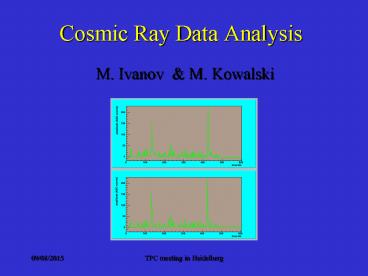Cosmic Ray Data Analysis - PowerPoint PPT Presentation
1 / 17
Title:
Cosmic Ray Data Analysis
Description:
Statistics 2316 cosmic events. Anode voltage 1245 V, drift field 400 V/cm ... In the cosmic data we register tracks with short drift and ... – PowerPoint PPT presentation
Number of Views:22
Avg rating:3.0/5.0
Title: Cosmic Ray Data Analysis
1
Cosmic Ray Data Analysis
M. Ivanov M. Kowalski
2
Experimental setup
3
- Run configuration
- Ne-CO2 (90/10)
- 1024 equipped channels
- Sampling frequency 10 MHz
- Statistics 2316 cosmic events
- Anode voltage 1245 V, drift field 400 V/cm
- O2 content 50-65 ppm
Raw data, processed then by the ALTRO offline
code (thanks to Roland Bramm)
4
Data processing ALTRO applied to 10 MHz
data, then, every second signal was taken to get
5 MHz data
5
Average occupancy ? 2
This is channel occupancy, not the event one.
6
Multiplicity
Simple cluster-finder and tracking (parabola)
7
Systematics
No significant systematics in pad (r?) direction
8
Restriction to rows 10-55
9
Test data vs. simulations, physics validation -
examples
In simulations - most probable Qmax 20 ADC
(MIP) (TDR for IROC)
Diffusion and electron capture
Average ionzation is ? 1.4 MIP , but the anode
voltage lower than the GARFIELD-based
estimate (1450 V).
10
In simulations, electronics response to a single
charge is a Gaussian with a FWHM 190 ns
Drift lt 5 cm, angles close to 0
Not far from reality
11
Single-cluster analysis
- Cuts
- Number of points per track gt 20
- Number of tracks lt 5
- ? or ? lt ? 10 deg
- ?2T,P lt 0.5 (time and pad units)
- Data analyzed in six drift-length intervals
- 0 - 22.4 cm
- 22.4 - 44.8 cm
- 44.8 67.2 cm
- 67.2 89.6 cm
- 89.6 112 cm
- 112 134.4 cm
12
Space-point resolution in r?
- Extrapolation
- to 0
- to 250 cm
Diffusion over 250 cm gives 640 ?m
13
Space-point resolution in z
- Extrapolation
- to 0
- to 250 cm
Diffusion 640 ?m
14
Cluster size in pad units
The most frequent clusters are 3-pad ones
COG method is O.K.
15
Cluster size in time units
Asymmetric (2-time bin) clusters for shorth drift
COG method gives poor results
16
Why it is so?
- Design of the ROC for the real ALICE TPC took
into - account following facts
- There are tracks with short drift and small
angle in pad - direction
- There are no tracks with short drift and small
angle in drift - direction small diffusion means a larger
angle and - vice versa
In the cosmic data we register tracks with short
drift and small angle in drift direction (not
ALICE-like) for them the time response is too
narrow.
17
Conclusions
- The ROC performance is close to the designed
- The further work on the time signal
symetrization - is required (Marian)
- The test beam runs would be useful (details
Joachim) - E-field quality should be improved (on the way)
- Oxygent content should be minimized
- Temperature and preasure should be monitored































